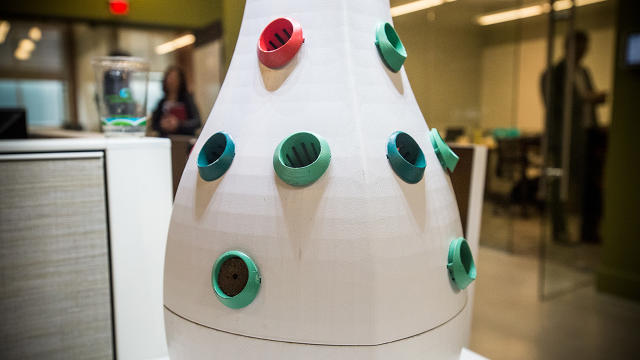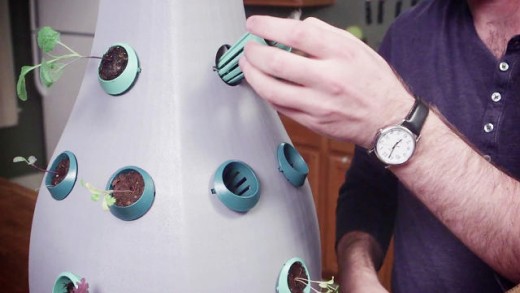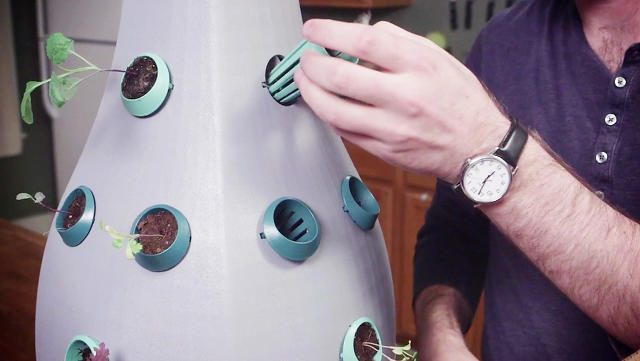This Smartphone-Connected Grower Is Like A Keurig For Marijuana
“Companies are trying to rebrand what cannabis is,” says Root cofounder Eric De Feo. “It’s no longer this whole Jerry Garcia vibe.”
When Brielle Pettinelli takes the stage, a subtle, awkward laughter trickles through the room. She’s here to talk about marijuana. And this particular crowd, comprised mostly of buttoned-up investors, is still getting used to having this conversation. But as the legal status and public perception of weed slowly evolves, Pettinelli isn’t waiting around.
Root, the product she’s pitching to potential funders this morning, aims to make it easier for anyone to grow their own cannabis at home. Even if these guys don’t get stoned in their spare time, her message at the DreamIt Ventures demo day on this rainy Monday in Philadelphia is compelling: This market is brand new and there’s a ton of money to be made.
Root is a two-foot-tall, inexpensive and Internet-connected device for growing cannabis at home—or really, anywhere you can get away with it. Paired with its smartphone app, the sleekly designed, pod-based hydroponic growing system allows people to harvest the green stuff without stressing too much about the details: Root will ding your phone if the plants are getting low on water or nutrients. It’s like a smart Keurig for your weed.
“Root is the first IoT planter,” Pettinelli brags, referring to the Internet of Things craze that has the tech industry—and the people funding it—so excited.
With her cofounder Eric De Feo, she launched Ohneka Farms, an urban farming startup from which Root is the first major product. After starting to raise funds on Indiegogo, Root joined this year’s class of startups in the DreamIt Ventures accelerator program. They’ve since been busily 3-D-printing prototypes, perfecting the device’s design and drumming up relationships with the activists, growers, and wellness organizations that are going to help turn products like this into moneymakers as the nation’s weed laws loosen up.
In reality, you can grow any plant using Root. And people will undoubtedly use the system, complete with its self-adjusting built-in lights and automatic nutrient distribution, to grow vegetables, herbs, and flowers at home—In fact, their original Indiegogo campaign initially focused on these uses. But their focus is now quite deliberately on reefer.
“We consider Root to be a health and wellness brand,” says De Feo. “All plants have medicinal benefits, and cannabis just so happens to be one of them.”
Indeed, De Feo and Pettinelli are aiming squarely at cannabis growers, because they see a market that’s about to explode—marijuana is estimated by some to be a $120 billion market worldwide and here in the U.S., marijuana prohibition laws are dropping quickly. Twenty-three states now allow medicinal marijuana, while three have legalized it for recreational use. These numbers are expected to keep climbing toward what feels to many like full-blown legalization.
“It’s been a fine line to walk, as this is a brand-new industry with obscure and inconsistent state-to-state laws,” admits De Feo. “Companies are trying to rebrand what cannabis is. It’s no longer this whole Jerry Garcia vibe. That’s all fun and great, but we’re trying to make it mainstream and acceptable.”
The enthusiasm they’ve seen so far, among both established growers and curious noobs, has been encouraging. “We’re aiming for a community of people who never grow because they thought they had an obstacle. Now they don’t.”
So how does Root plan to make money? At $299, the device itself may give amateurs pause. Self-watering planters like AliGro and Click & Grow are available for $60 and $80, respectively, but neither packs the features, growing capacity, and Nest-like smartphone syncing that Root offers.

Either way, Root is a steal to traditional growers, who are accustomed to spending that much money on a growing class or a replacement lamp. To be fair, the scale of Root’s output is much smaller than what most professional growers are used to—it can only grow 16 seedlings at a time, although De Feo is toying with the idea of making the growing tower extensible so users can fit more plants in it.
“We’re targeting the cannabis market first, because those are the people who are most receptive and because they are the people who are already growing themselves,” says De Feo. “This is something that’s helping their process.”
Root’s business model won’t rely on hardware sales alone. The company will also sell growing kits—seeds, soil, and nutrients that come prepackaged and ready to roll like a coffee K-cup. These will be sold individually or as a recurring subscription.
Like any startup worth investing in, Root is thinking about how to extract value from its data as well. Once the device starts shipping at the end of the summer, it will start collecting usage data in aggregate and, in time, use that insight to improve the product.
In addition to the usual challenges of software development and designing a functional piece of hardware, startups like Root face a unique hurdle: the stigma of weed. Even as U.S. marijuana prohibition thaws and investors start opening their wallets, weed is living down decades of being classified as a Schedule I drug by the federal government—a status it still hasn’t shed, by the way. Even among those who aren’t freaked out by pot, the mere concept of growing it at home with ease is often a new one. So for Root and other companies trying to leap headfirst into the new weed economy, much of their pitch is about educating people.

“There’s nothing on the market yet like this and hydroponics are so new, so you do have to explain it,” says Pettinelli. “When you show it to people in action, they’re like, ‘Oh, I didn’t even realize you could grow plants in such a tight amount of space!’ Part of our core mission is education as well.”
Over the course of the next few weeks, Root will enter the production phase. A select group of partners will get to beta-test the device this summer and, if all goes according to plan, it will start shipping before the fall. If they do manage to get a round of funding, Pettinelli and De Feo say they’ll pour it into marketing, growing their team and starting to work on other products. In the meantime, there are functional details to perfect, software bugs to iron out.
“We’re an IoT product so we’ll have constant updates with our app,” says Pettinelli. “We’re going to go with the flow.”
Related: Meet the world’s first cannabis editor
Fast Company , Read Full Story
(175)














